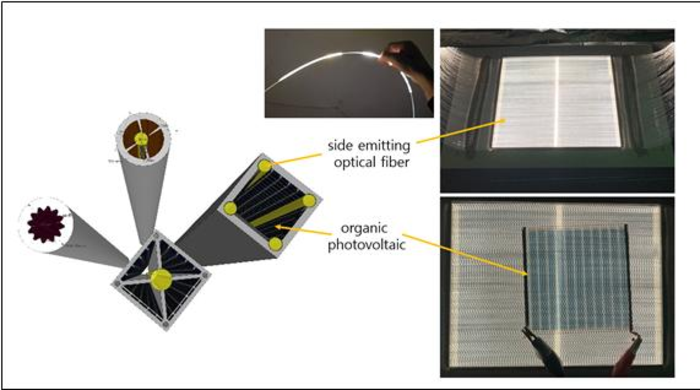Scientists from the Korea Institute of Materials Science (KIMS) and Solar Optics, a South Korean optics application material research company, have developed a new power generation system based on optical fibers and organic solar cells.
The advantage of a fiber-optic solar-cell system over a planar one is that light scatters inside the optical fiber as it moves along its length, providing more opportunities to interact with the solar cell itself on its inner surface, generating more power. Fiber solar cells also require less surface area than planar cells, as the long lengths of the fibers can be embedded into the structure of buildings, like electrical wiring.
The research team adapted the structure of the organic solar cell to optimize light scattering and absorption through nano-sized holes pierced on the surface of a special optical fiber called Optical Side Lighting (OSD).
“This enabled to install the optical fiber and the solar panel in a vertical three-dimensional structure and maintain the generation efficiency for a long time regardless of the angle of the panel,” the academics said. “The power generation efficiency is greatly improved and the maximum efficiency time of the solar panel is also increased to an average of six hours or more per day.”
They used side-emitting optical fibers to operate the system in an unstable outdoor environment. “It is also possible to adopt high-efficiency panels that have not been used in the past because they are sensitive to external environments such as heat, dust, and humidity,” they explained.
Popular content
Researcher Dong Chan Lim noted that the proposed system configuration could be used for high-efficiency products.
“Recently, materials for organic solar cells with 20% or more power generation efficiency are continuously being developed, but there is a concern due to the nature of organic material which would be vulnerable to heat or humidity,” said Dong. “This technology can significantly reduce the area for solar power generation by about a fifth or more, and be used for portable solar generators, electric vehicles, and distributed power generation systems.”
Solar Optics and KIMS said they are currently seeking to commercialize the world’s first high-efficiency solar power facilities based on the OSD, but they did not provide any additional details.
This content is protected by copyright and may not be reused. If you want to cooperate with us and would like to reuse some of our content, please contact: editors@pv-magazine.com.



Is there a graphic available that shows how this works? The written description is insufficient for understanding the mechanisms behind how this works.